Citroen DS4 RHD 2013.5 1.G Owner's Manual
Manufacturer: CITROEN, Model Year: 2013.5, Model line: DS4 RHD, Model: Citroen DS4 RHD 2013.5 1.GPages: 400, PDF Size: 31.86 MB
Page 251 of 400
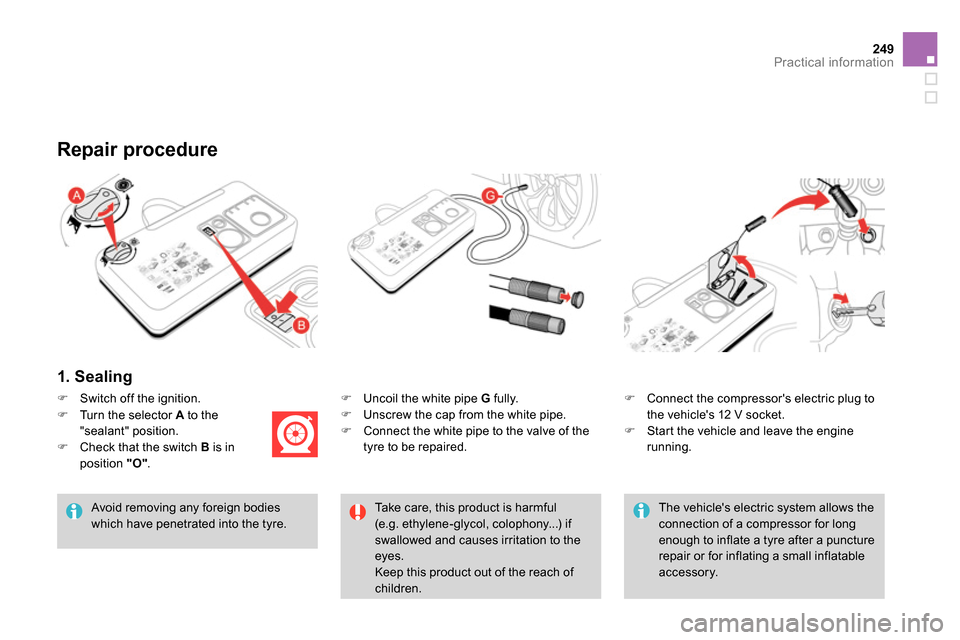
249Practical information
1. Sealing
Uncoil the white pipe G
fully.
Unscrew the cap from the white pipe.
Connect the white pipe to the valve of the
tyre to be repaired.
Repair procedure
Avoid removing any foreign bodies
which have penetrated into the tyre.
Connect the compressor's electric plug to
the vehicle's 12 V socket.
Start the vehicle and leave the engine
running.
Switch off the ignition.
Take care, this product is harmful
(e.g. ethylene-glycol, colophony...) if
swallowed and causes irritation to the
eyes.
Keep this product out of the reach of
children.
Turn the selector A
to the
"sealant" position.
Check that the switch B
is in
position "O"
.
The vehicle's electric system allows the
connection of a compressor for long
enough to inflate a tyre after a puncture
repair or for inflating a small inflatable
accessory.
Page 252 of 400
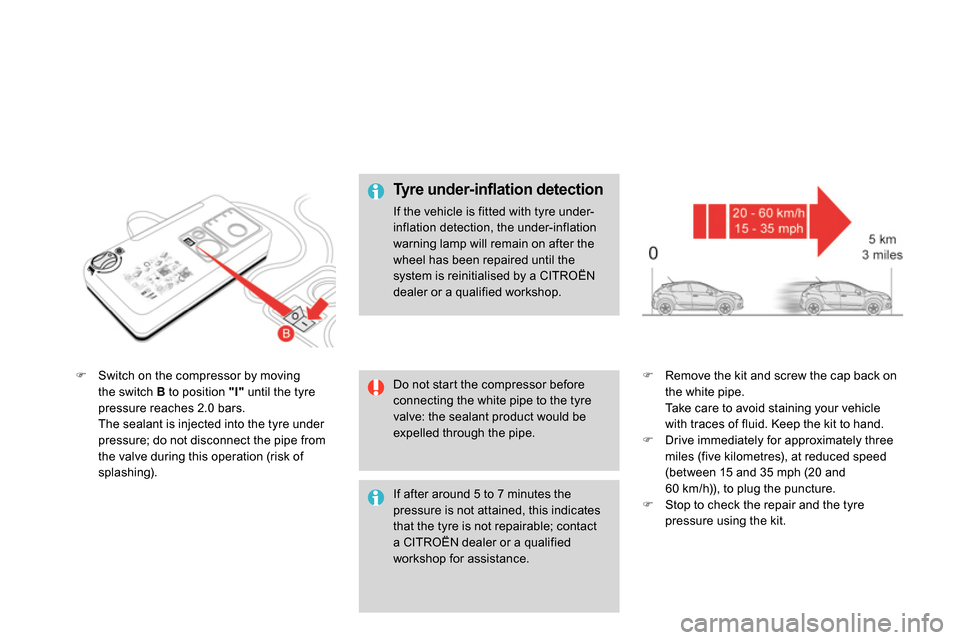
Switch on the compressor by moving
the switch B
to position "I"
until the tyre
pressure reaches 2.0 bars.
The sealant is injected into the tyre under
pressure; do not disconnect the pipe from
the valve during this operation (risk of
splashing).
Remove the kit and screw the cap back on
the white pipe.
Take care to avoid staining your vehicle
with traces of fluid. Keep the kit to hand.
Drive immediately for approximately three
miles (five kilometres), at reduced speed
(between 15 and 35 mph (20 and
60 km/h)), to plug the puncture.
Stop to check the repair and the tyre
pressure using the kit.
Do not start the compressor before
connecting the white pipe to the tyre
valve: the sealant product would be
expelled through the pipe.
Ty r e u n d e r - i nfl ation detection
If the vehicle is fitted with tyre under-
inflation detection, the under-inflation
warning lamp will remain on after the
wheel has been repaired until the
system is reinitialised by a CITROËN
dealer or a qualified workshop.
If after around 5 to 7 minutes the
pressure is not attained, this indicates
that the tyre is not repairable; contact
a CITROËN dealer or a qualified
workshop for assistance.
Page 253 of 400
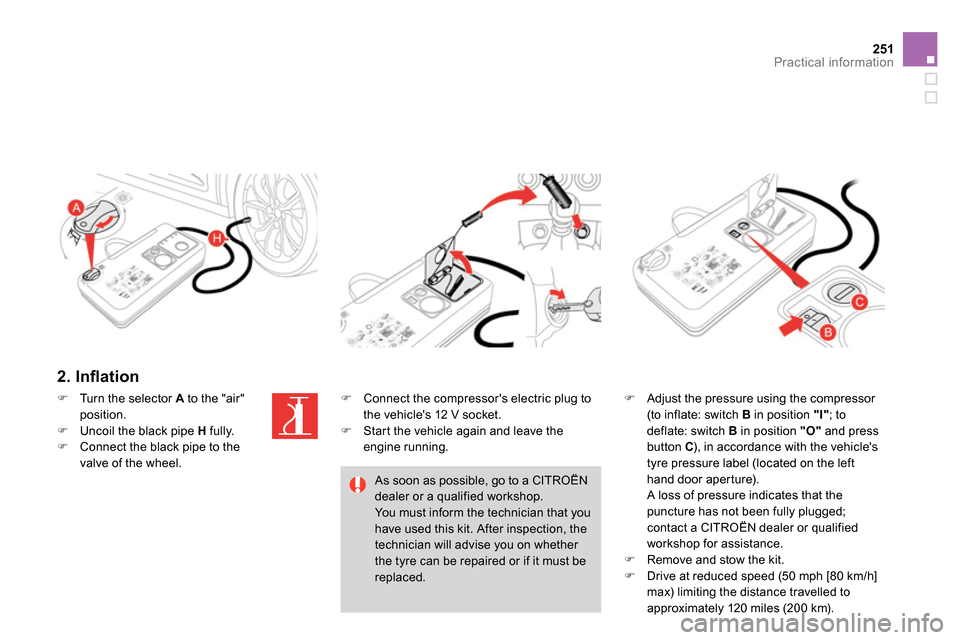
251Practical information
2. Infl ation
Adjust the pressure using the compressor
(to inflate: switch B
in position "I"
; to
deflate: switch B
in position "O"
and press
button C
), in accordance with the vehicle's
tyre pressure label (located on the left
hand door aperture).
A loss of pressure indicates that the
puncture has not been fully plugged;
contact a CITROËN dealer or qualified
workshop for assistance.
Remove and stow the kit.
Drive at reduced speed (50 mph [80 km/h]
max) limiting the distance travelled to
approximately 120 miles (200 km).
Turn the selector A
to the "air"
position.
Uncoil the black pipe H
fully.
Connect the black pipe to the
valve of the wheel.
Connect the compressor's electric plug to
the vehicle's 12 V socket.
Start the vehicle again and leave the
engine running.
As soon as possible, go to a CITROËN
dealer or a qualified workshop.
You must inform the technician that you
have used this kit. After inspection, the
technician will advise you on whether
the tyre can be repaired or if it must be
replaced.
Page 254 of 400
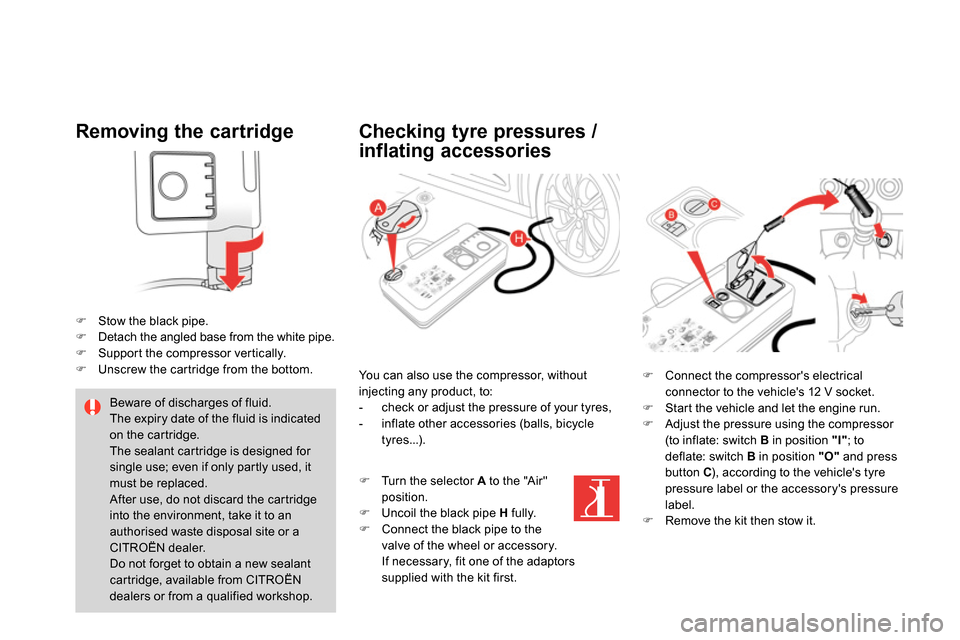
Removing the cartridge
Stow the black pipe.
Detach the angled base from the white pipe.
Support the compressor vertically.
Unscrew the cartridge from the bottom.
Checking tyre pressures /
inflating accessories
Beware of discharges of fluid.
The expiry date of the fluid is indicated
on the cartridge.
The sealant cartridge is designed for
single use; even if only partly used, it
must be replaced.
After use, do not discard the cartridge
into the environment, take it to an
authorised waste disposal site or a
CITROËN dealer.
Do not forget to obtain a new sealant
cartridge, available from CITROËN
dealers or from a qualified workshop.
You can also use the compressor, without
injecting any product, to:
- check or adjust the pressure of your tyres,
- inflate other accessories (balls, bicycle
tyres...).
Connect the compressor's electrical
connector to the vehicle's 12 V socket.
Start the vehicle and let the engine run.
Adjust the pressure using the compressor
(to inflate: switch B
in position "I"
; to
deflate: switch B
in position "O"
and press
button C
), according to the vehicle's tyre
pressure label or the accessory's pressure
label.
Remove the kit then stow it.
Turn the selector A
to the "Air"
position.
Uncoil the black pipe H
fully.
Connect the black pipe to the
valve of the wheel or accessory.
If necessary, fit one of the adaptors
supplied with the kit first.
Page 255 of 400
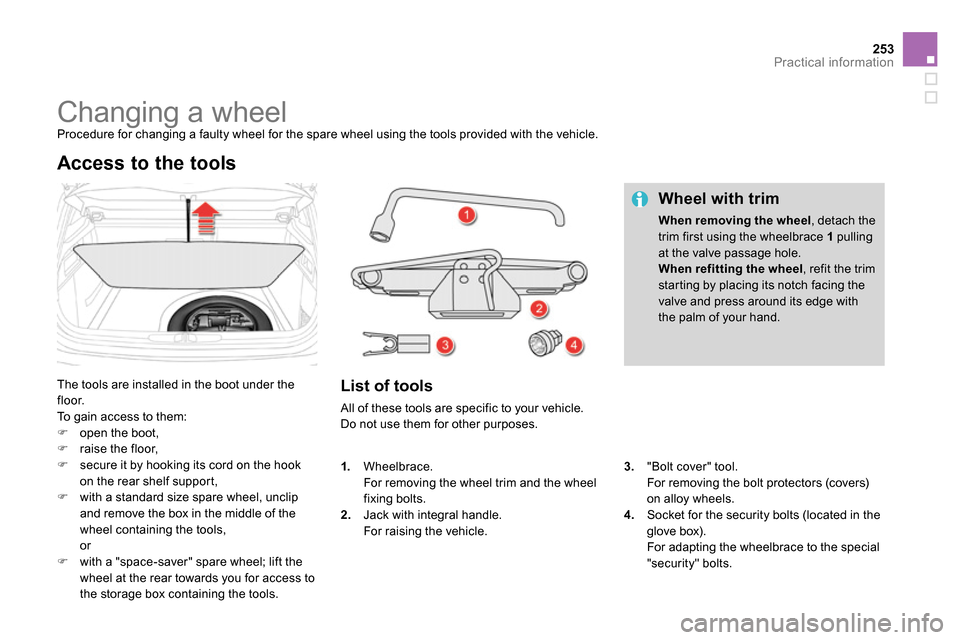
253Practical information
Changing a wheel
Procedure for changing a faulty wheel for the spare wheel using the tools provided with the vehicle.
The tools are installed in the boot under the
floor.
To gain access to them:
open the boot,
raise the floor,
secure it by hooking its cord on the hook
on the rear shelf support,
with a standard size spare wheel, unclip
and remove the box in the middle of the
wheel containing the tools,
or
with a "space-saver" spare wheel; lift the
wheel at the rear towards you for access to
the storage box containing the tools.
Access to the tools
List of tools
All of these tools are specific to your vehicle.
Do not use them for other purposes.
Wheel with trim
When removing the wheel
, detach the
trim first using the wheelbrace 1
pulling
at the valve passage hole.
When refitting the wheel
, refit the trim
starting by placing its notch facing the
valve and press around its edge with
the palm of your hand.
3.
"Bolt cover" tool.
For removing the bolt protectors (covers)
on alloy wheels.
4.
Socket for the security bolts (located in the
glove box).
For adapting the wheelbrace to the special
"security" bolts.
1.
Wheelbrace.
For removing the wheel trim and the wheel
fixing bolts.
2.
Jack with integral handle.
For raising the vehicle.
Page 256 of 400
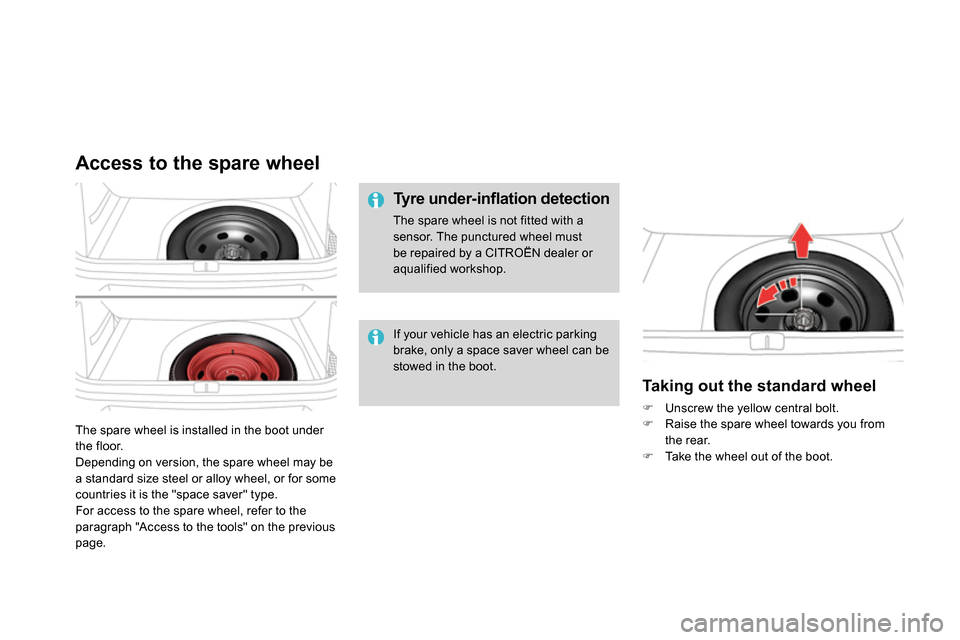
The spare wheel is installed in the boot under
the floor.
Depending on version, the spare wheel may be
a standard size steel or alloy wheel, or for some
countries it is the "space saver" type.
For access to the spare wheel, refer to the
paragraph "Access to the tools" on the previous
page.
Access to the spare wheel
Ty r e u n d e r - i nfl ation detection
The spare wheel is not fitted with a
sensor. The punctured wheel must
be repaired by a CITROËN dealer or
aqualified workshop.
Taking out the standard wheel
Unscrew the yellow central bolt.
Raise the spare wheel towards you from
the rear.
Take the wheel out of the boot.
If your vehicle has an electric parking
brake, only a space saver wheel can be
stowed in the boot.
Page 257 of 400
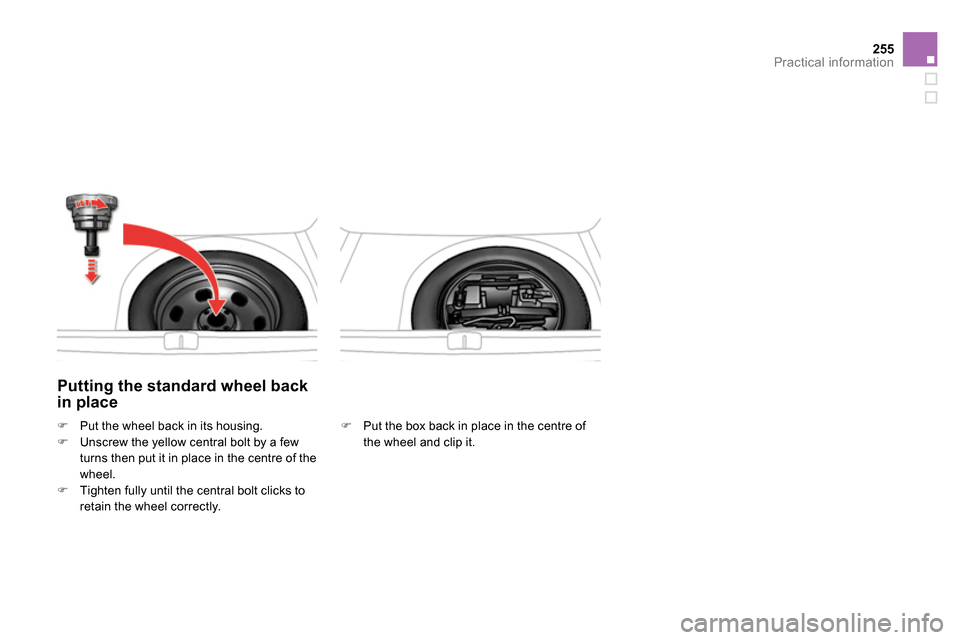
255Practical information
Putting the standard wheel back
in place
Put the box back in place in the centre of
the wheel and clip it.
Put the wheel back in its housing.
Unscrew the yellow central bolt by a few
turns then put it in place in the centre of the
wheel.
Tighten fully until the central bolt clicks to
retain the wheel correctly.
Page 258 of 400
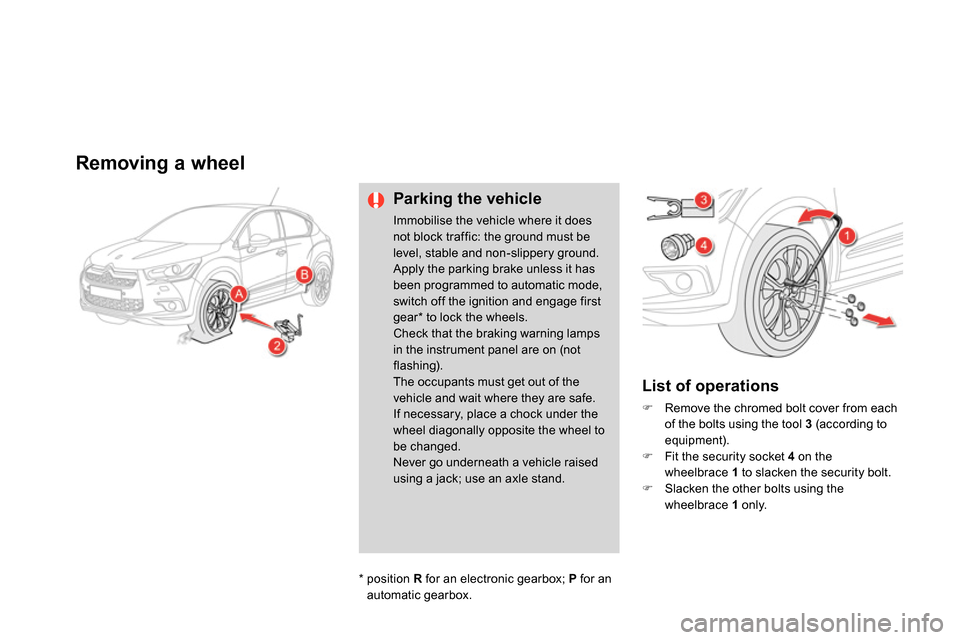
Removing a wheel
Parking the vehicle
Immobilise the vehicle where it does
not block traffic: the ground must be
level, stable and non-slippery ground.
Apply the parking brake unless it has
been programmed to automatic mode,
switch off the ignition and engage first
gear * to lock the wheels.
Check that the braking warning lamps
in the instrument panel are on (not
flashing).
The occupants must get out of the
vehicle and wait where they are safe.
If necessary, place a chock under the
wheel diagonally opposite the wheel to
be changed.
Never go underneath a vehicle raised
using a jack; use an axle stand.
List of operations
Remove the chromed bolt cover from each
of the bolts using the tool 3
(according to
equipment).
Fit the security socket 4
on the
wheelbrace 1
to slacken the security bolt.
Slacken the other bolts using the
wheelbrace 1
only.
*
position R
for an electronic gearbox; P
for an
automatic gearbox.
Page 259 of 400
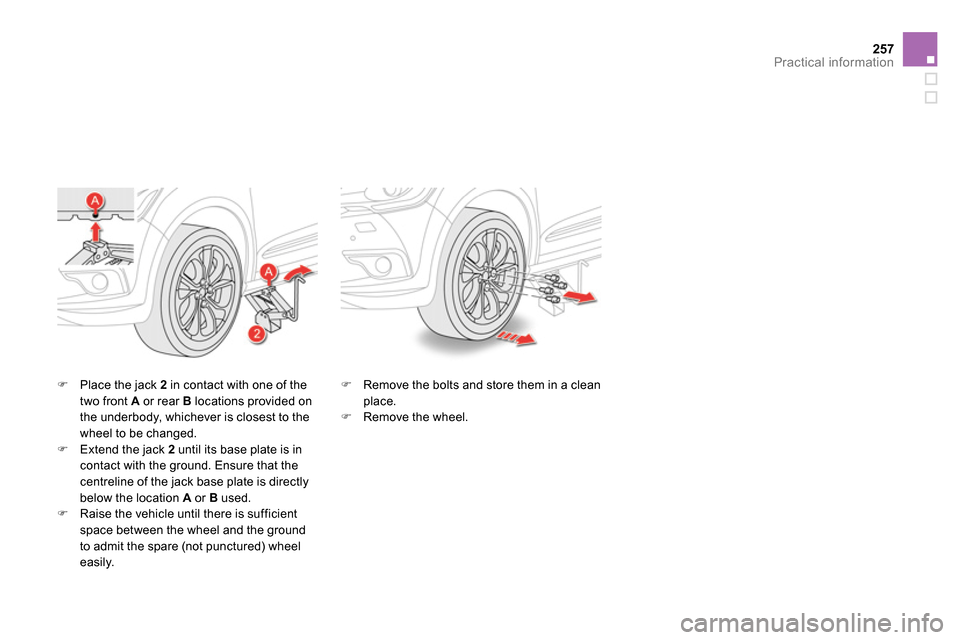
257Practical information
Place the jack 2
in contact with one of the
two front A
or rear B
locations provided on
the underbody, whichever is closest to the
wheel to be changed.
Extend the jack 2
until its base plate is in
contact with the ground. Ensure that the
centreline of the jack base plate is directly
below the location A
or B
used.
Raise the vehicle until there is sufficient
space between the wheel and the ground
to admit the spare (not punctured) wheel
easily.
Remove the bolts and store them in a clean
place.
Remove the wheel.
Page 260 of 400
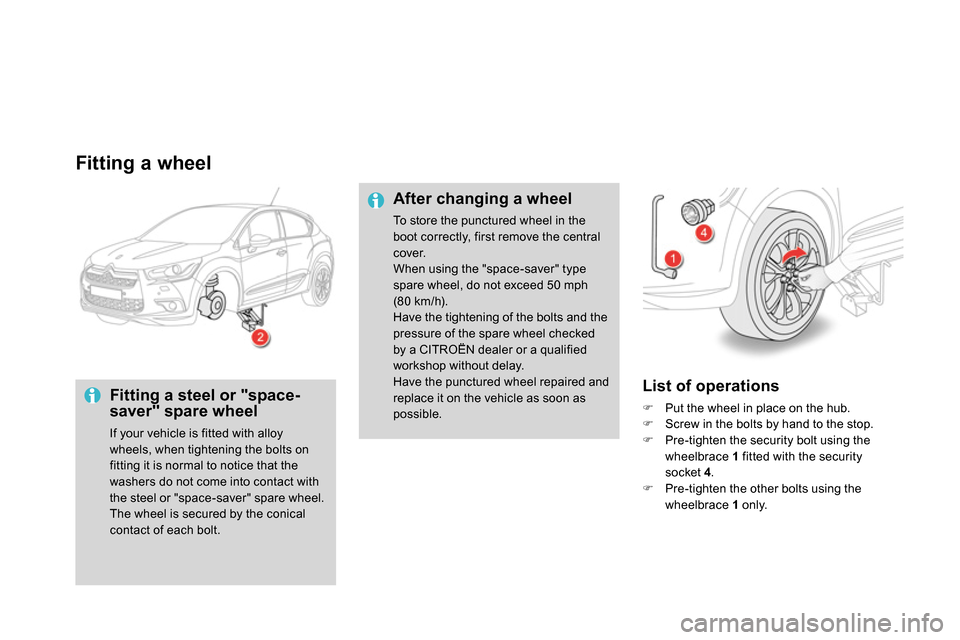
Fitting a wheel
Fitting a steel or "space-
saver" spare wheel
If your vehicle is fitted with alloy
wheels, when tightening the bolts on
fitting it is normal to notice that the
washers do not come into contact with
the steel or "space-saver" spare wheel.
The wheel is secured by the conical
contact of each bolt.
List of operations
Put the wheel in place on the hub.
Screw in the bolts by hand to the stop.
Pre-tighten the security bolt using the
wheelbrace 1
fitted with the security
socket 4
.
Pre-tighten the other bolts using the
wheelbrace 1
only.
After changing a wheel
To store the punctured wheel in the
boot correctly, first remove the central
cover.
When using the "space-saver" type
spare wheel, do not exceed 50 mph
(80 km/h).
Have the tightening of the bolts and the
pressure of the spare wheel checked
by a CITROËN dealer or a qualified
workshop without delay.
Have the punctured wheel repaired and
replace it on the vehicle as soon as
possible.